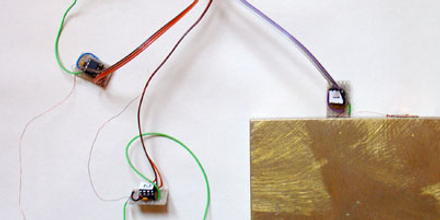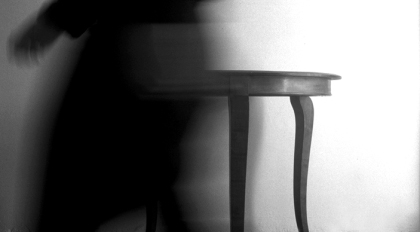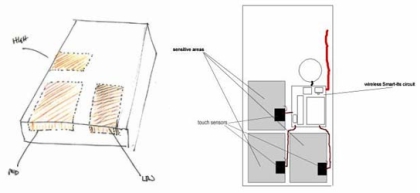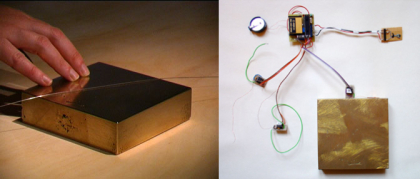
I am interested in things that do things. Electronics, sensors, things that react to people moving them, holding them, blowing on them, touching them, and things that make sound when you do these things. I'm not interested in interaction that does 1+1=2, or at least I'm interested in testing what the boundary is between utter frustration and a more "aesthetic interaction" where incongruities can reveal a different kind of relationship between the person doing things with the thing and the thing itself.

I'm trying to teach myself electronics and various software to interface with it but with limited success so far. This is taking time. Most of the time when opportunities have come up, I have had to pay for someone to do it for me. Over the last four years I have been lucky enough to receive little bits of funding from here and there to develop some of these ideas. As a result I've developed a series of "sound objects", which are at various points of completion and use different interactive technologies. These have all involved varying lengths of research and development in collaboration to varying degrees with different people. Lots of variables! This page documents some of these devices. Many of them are still at the prototype stages, perhaps at one or two iterations. They all need more work and development.
Table Phonograph
I like tables, specially old wooden ones with weathered and worn surfaces. I liked the idea of listening to a table, so I made Table Phonograph with the help of an Alt-w Research & Development Fund in 2002.

The first prototype of Table Phonograph was very simple. It used an old record player cartridge which was wired up to a pre-amp. When this was traced over a bumpy surface it made a scratchy sound. I liked this but it was irregular and erratic. It was difficult to apply consistent pressure to get a continual sound.

With the funding I asked someone to help me make a device to listen to tables with. It took us a while to understand each other and he asked me lots of questions, like was I interested in reading the texture, or the picture of the surface? What was the table going to made out of? Or was I interested only in the idea of listening to a table? He also pointed out that tables don't make sound unless you knock or tap them, so where did i want the sound to come from? These were all very difficult questions to answer. I didn't know. I just wanted to hold a small device and trace it over a table surface and hear the different sounds that this act made as it moved across the surface. I explained as best I could, and he listened as best he could. We agreed that an optical sensor might be the best sensor to use as this could literally measure texture.
This second, and then, third prototype was quite a bit more complicated. It took six months and cost lots of money, but probably not enough to cover the time spent on developing the device. In the end I was disappointed with the end result and frustrated. I learned a lot about how difficult it is to communicate your ideas into a material you don't understand, and how much development time is needed for these things.
Ingot
After this experience I was cautious. I did some some research and while doing a Hothaus Residency at VIVID in Birmingham I came across Smart-its, a D.I.Y. wireless sensor kit being developed in the Dept. of Computing at Lancaster University. I made a visit and talked about my desire to listen to table surfaces. They invited me back to take part in one of their practical workshops where I assembled my own Smart-its device, and talked about sensors and how to get them talking to a computer for two-days. PhD student, Nicolas Villar took me under his wing, and together we made the first iteration of Ingot.

It was decided to change track slightly and I decided to work with a capacitive sensor - touch and a humidity sensor - breath. The capacitive sensor works with the natural level of electricity we all have in the skin. This means the sensor can be extended using copper wire or other metal surfaces, and can be triggered when touched. The humidity sensor measures dew or moisture levels. I wanted to use these components to make a precious and intimate object that could be interacted with to make sound. We decided on programming the Smart-its sensor devices to use MIDI signals so that it could be interfaced with LiSa sound sequencing software developed by Steim. LiSa could deal with the sound samples, once the sensors were sending signals it could read. The humidity sensor sent an analogue signal which could be translated to a Pitchbend message in Midi, and the capacitive sensor sent a digital signal, a 0 or 1 which translated easily to an On/Off Midi signal. Nicolas programmed the On/Off signal so they simulated a stepped analogues signal, i.e. so the went from 0 to 1 over ten steps.

I decided to make the object an ingot of brass which could be touched and blown on to create sound. It was planned to use three capacitive sensors and one humidity sensor. Each capacitive sensor would be allocated to either a high, medium or low pitch sound, and the sound allocated to the Pitchbend signal could be used as a counterpoint and compostional tool.
In May 2003 I undertook a two-week LiSa Orientation Residency with the Smart-its devices at

Ingot was later adapted to as an element to be included in the installation aerial (brass)It was simplified to use only one capacitive sensor.

devices
electronic sound objects & prototypes
2002 - now
These projects have been supported by a Research & Development Grant, Alt-w; VIVID; Scottish Arts Council & Steim, Amsterdam.
